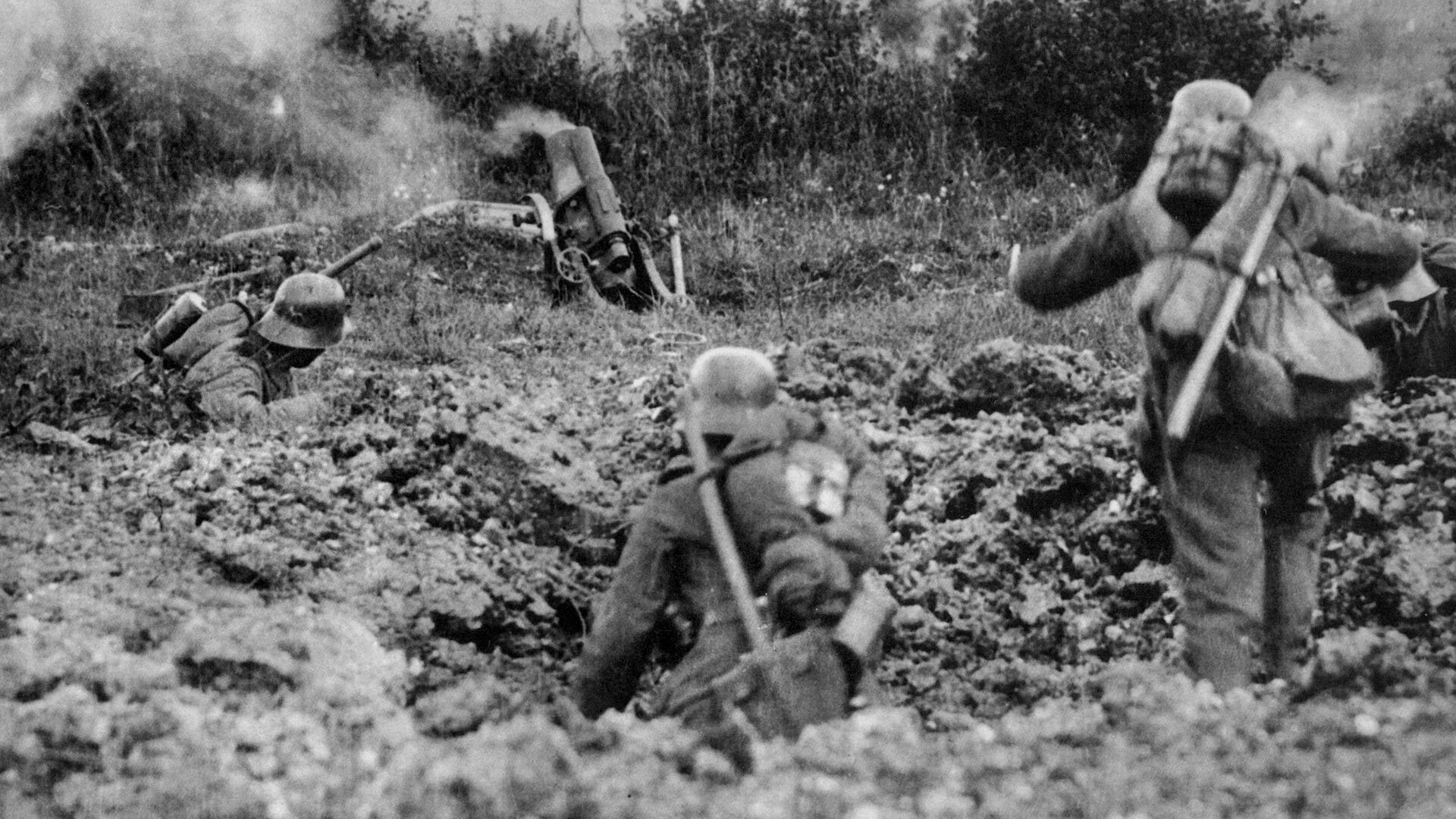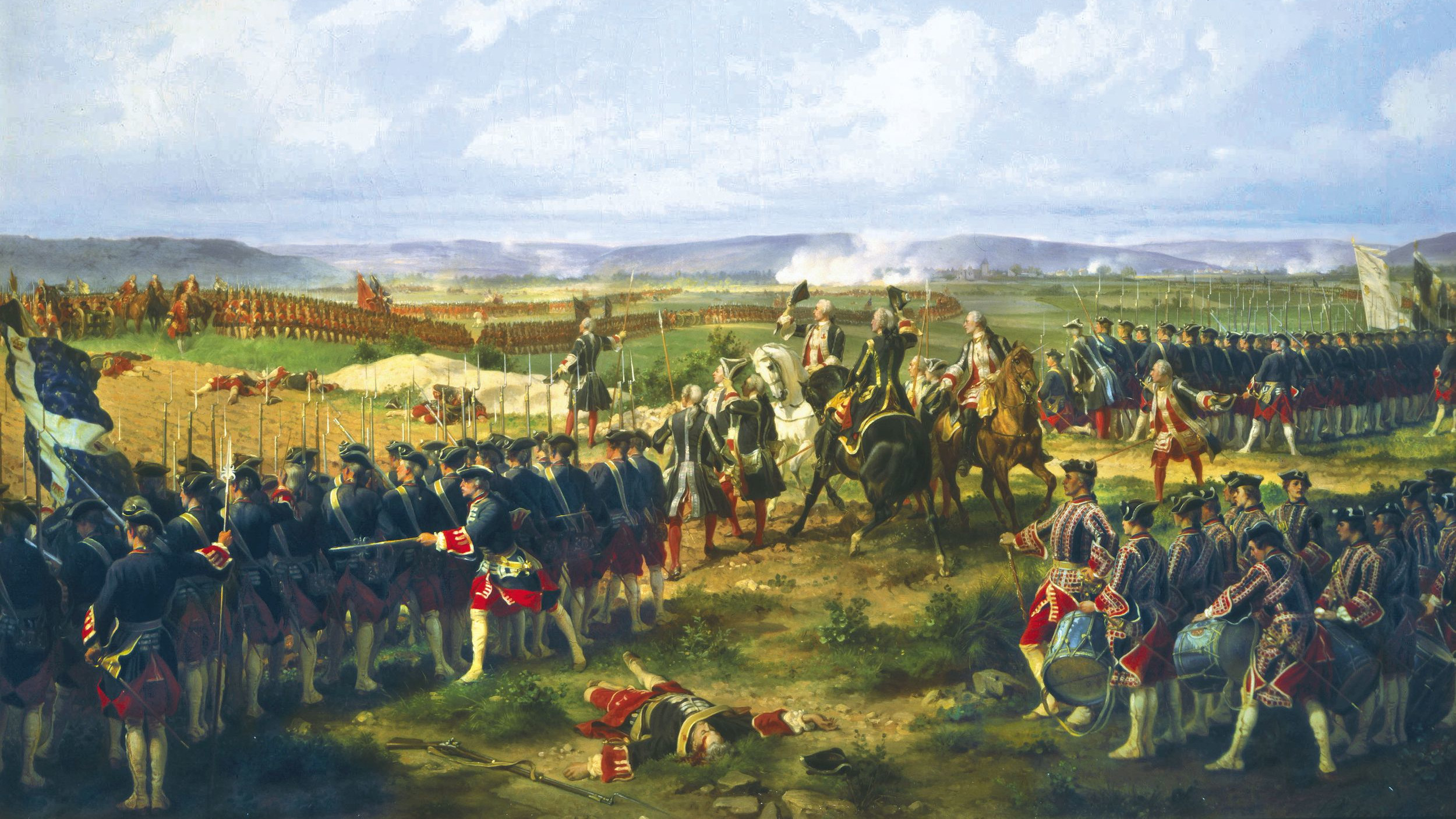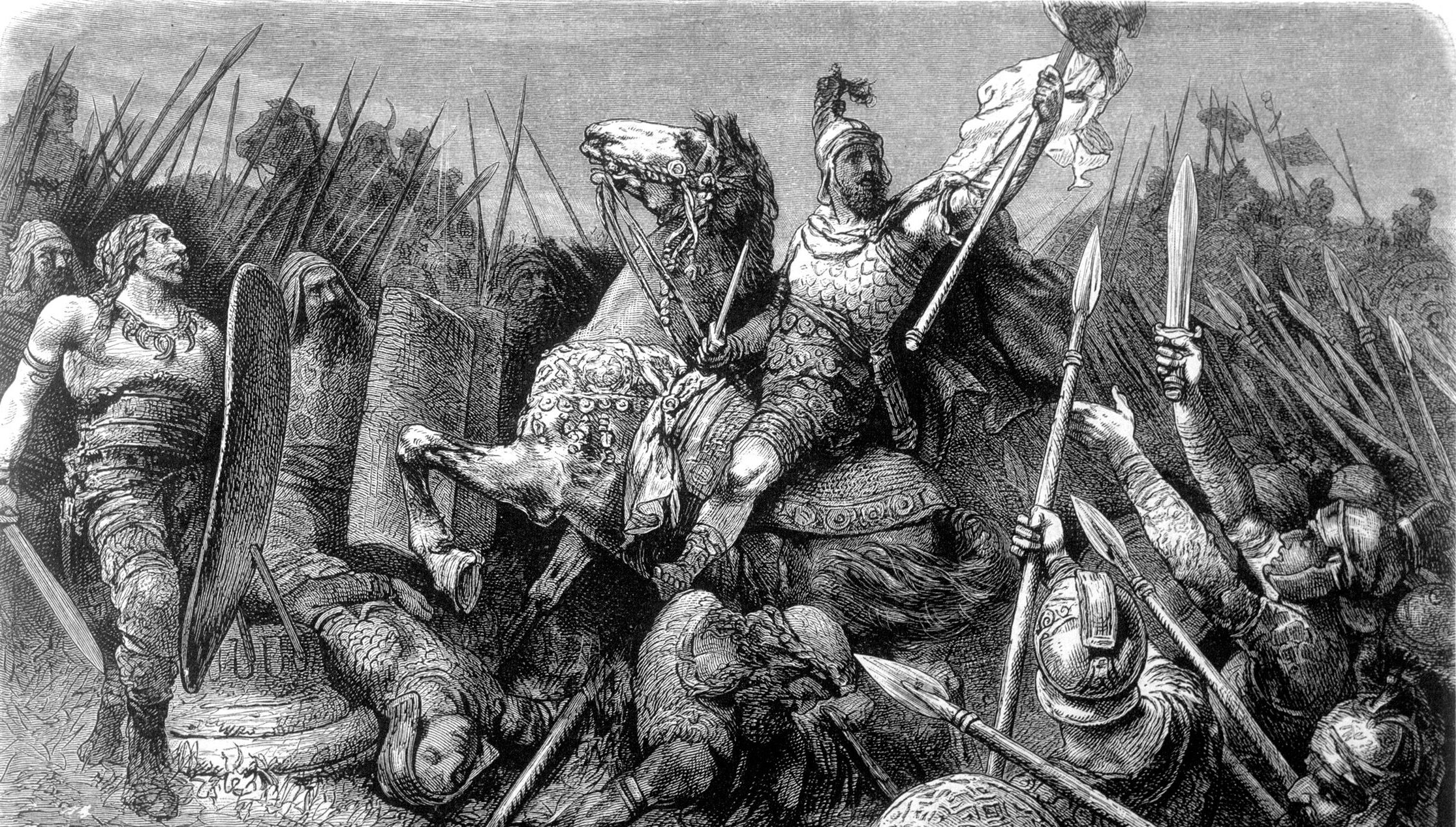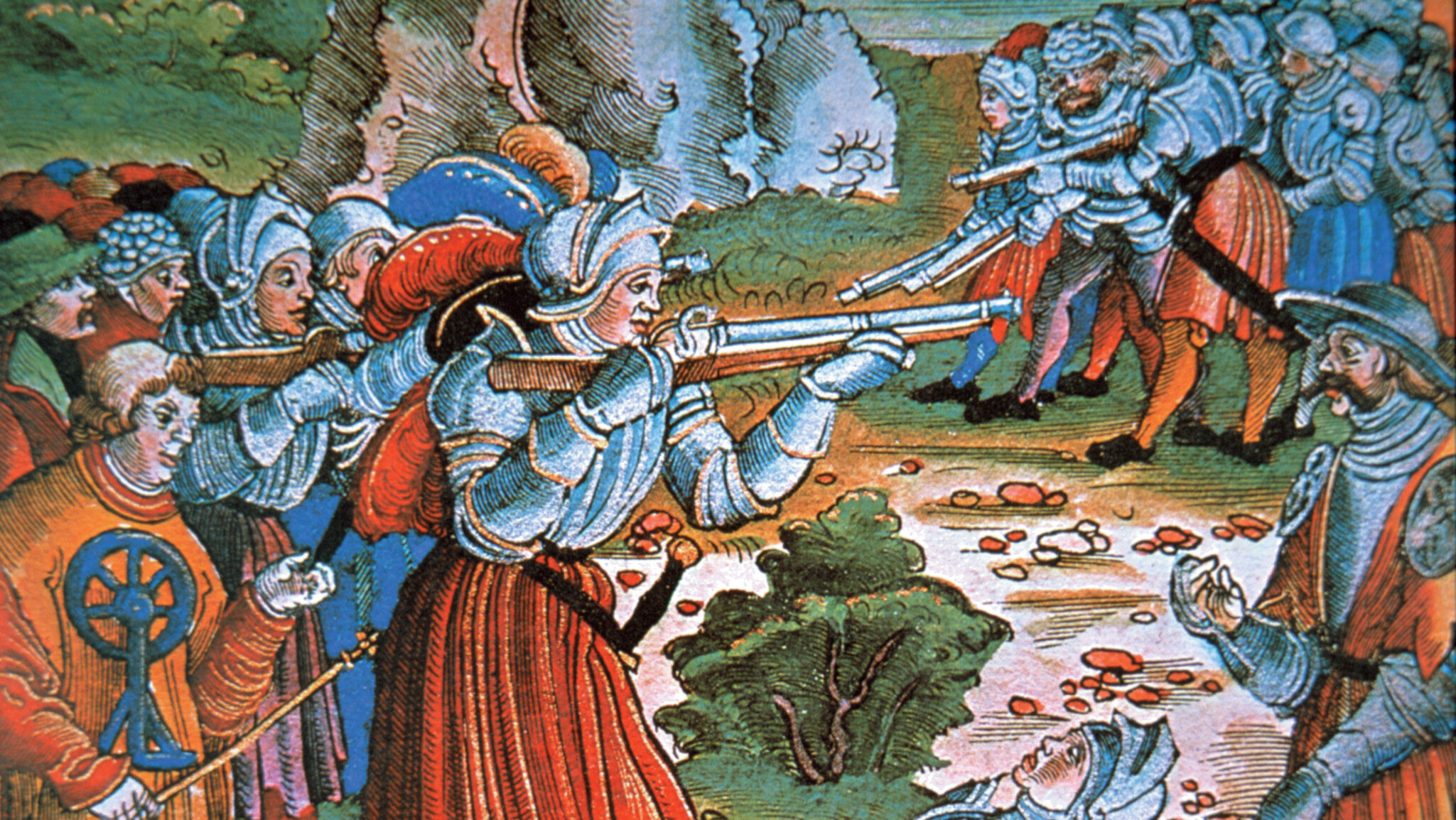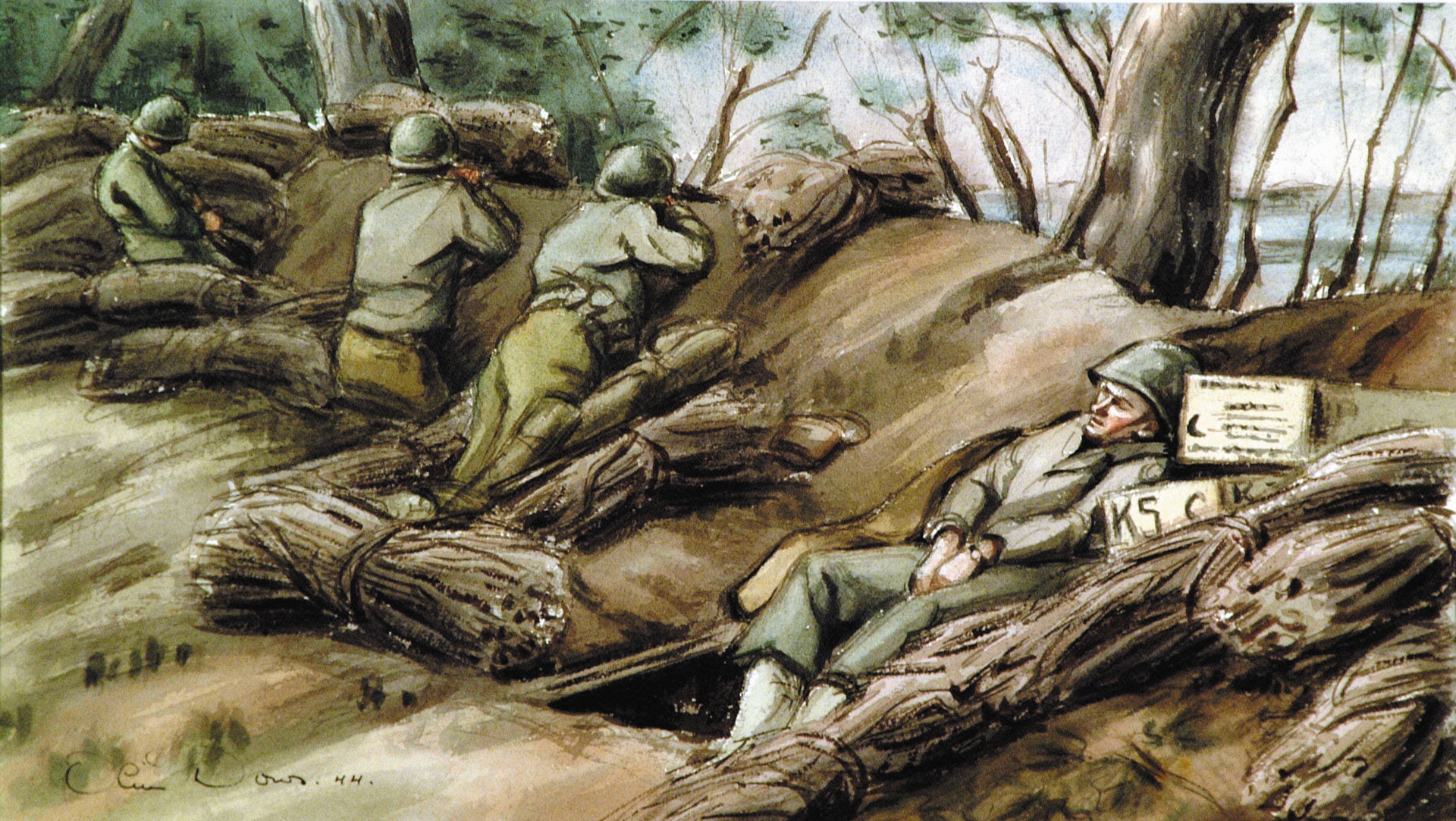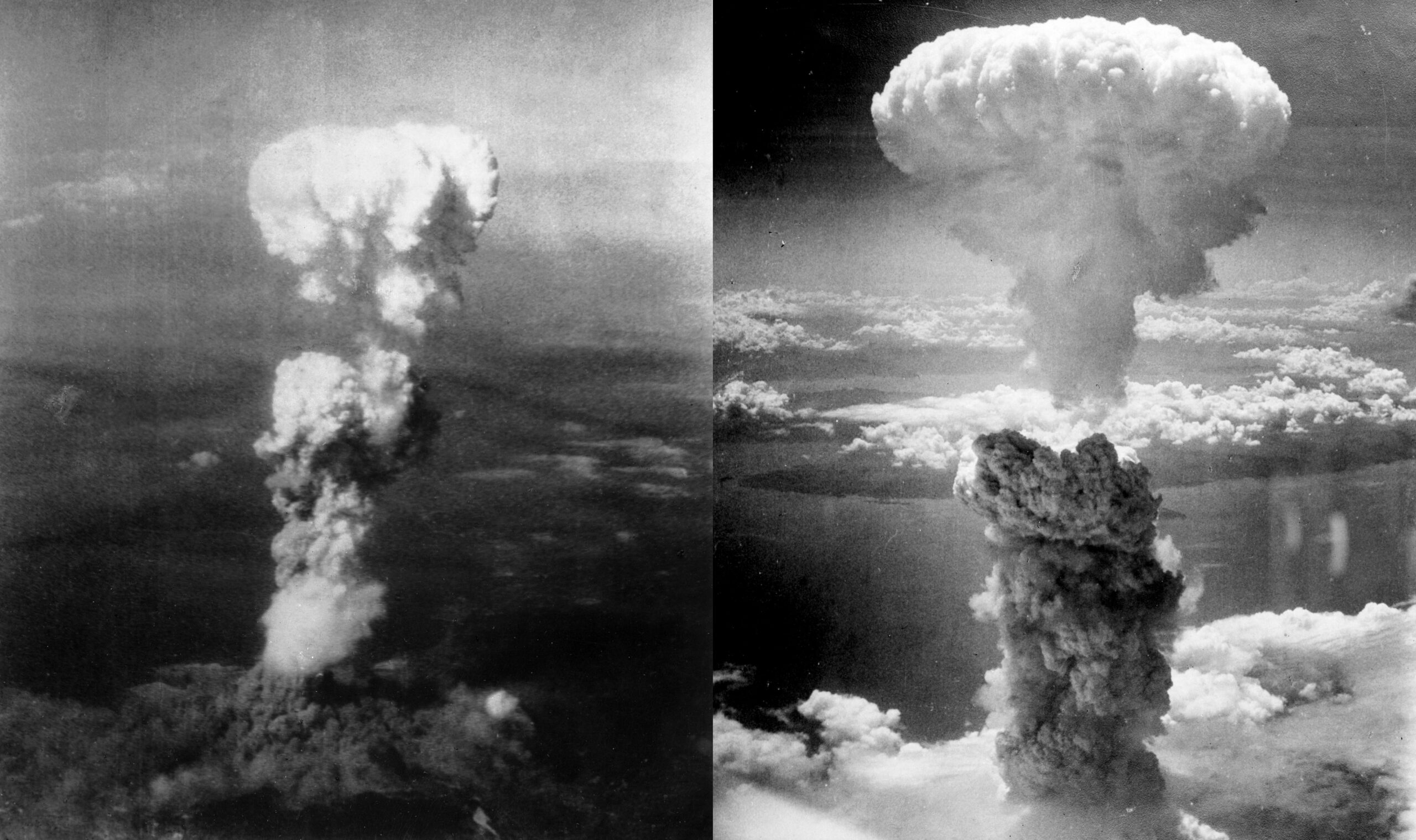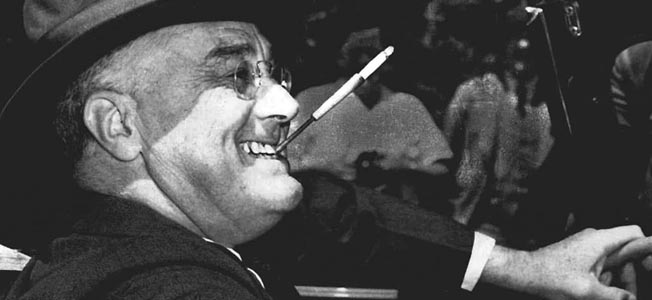By Mike Phifer
German artillery officers watched as a white rocket streaked across the dark sky above the French village of St. Quentin. It was dawn on March 21, 1918, and these officers knew this was the signal to fire their guns. Elsewhere in other sectors, single heavy guns fired the signal round. The dark sky came alive with the horrendous roar of artillery fire as 6,473 guns opened up. Joining in with the artillery were 3,352 mortars sending death and misery toward enemy lines. For five hours, sweating German gunners relentlessly fired more than one million shells, focusing mostly on a 50-mile stretch of the British lines between the Sensée and Oise Rivers. Deploying every weapon in their arsenal, the Germans had even mixed in gas shells with their regular high-explosive ammunition.
As the appointed time began to draw near, some of the German troops quietly prayed; others sang songs. While the earthshaking bombardment continued, specially trained storm troops, accompanied by pioneers, slipped out of the trenches in midmorning and cut gaps in their barbed-wire defenses. German officers issued orders at 9:40 AM for a general advance. Some troops had actually advanced earlier in certain sectors.
The storm troops and other designated units pushed forward into a heavy fog that shrouded the battlefield. Hundreds of thousands of troops prepared to follow them when given the signal. After three and a half years of horrific fighting, many of the German Army troops believed they were on the verge of a great victory that would win the war for Germany once and for all.
By early 1918, the German High Command had good reason to believe that they could tip the strategic balance on the Western Front in Germany’s favor. The war on the Eastern Front was over. A communist revolution had overthrown the tsarist government in Russia, and the new regime quit the fight in late 1917. Suing for peace, the Bolsheviks formally surrendered to the Central Powers with the Treaty of Brest-Litovsk, which they signed on March 3, 1918. On the Italian front, Austro-Hungarian armies reinforced by veteran German units had routed Marshal Luigi Cadorna’s army at Caporetto in autumn 1917. These developments freed up numerous German divisions that were sent west, swelling German troop strengths on the Western Front to 192 divisions totaling 3.5 million troops by early March 1918.
On the other hand, the entry of the United States into World War I in April 1917 posed a major challenge to the Germans. Once the Germans had gained numerical superiority on the Western Front, General Erich Ludendorff planned to unleash a major offensive before the rapidly growing American Expeditionary Force gave the Allies military superiority. The Germans also had to act quickly because the Royal Navy’s worsening blockade, which was causing severe food and raw-material shortages in Germany, provided another prod to action as well.
On November 11, 1917, Ludendorff held a meeting at Mons, Belgium, with his chiefs of staff to discuss a spring offensive on the Western Front. Ludendorff already had fixed in his mind that the spring offensive would fall on the British. In the months that followed, the German High Command weighed different options, including an attack on the French, but Ludendorff had no intention of focusing on the French. “We must beat the British,” he said.
Ludendorff justified this on the grounds that the British would be more likely to sign an armistice than the French, given that they were not fighting on their own soil. The Germans produced three plans for attacking the British: one aimed at Flanders, code-named George; another for Arras in the Pas-de-Calais, code-named Mars; and one code-named Michael focusing on the German-held town of St. Quentin in the Aisne region, where the British right flank met the French left flank.
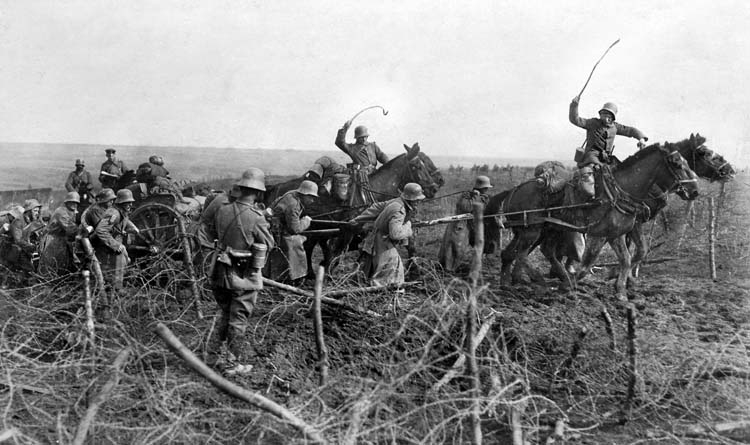
Following these deliberations, the scope of Operation Michael was expanded north almost as far as Arras. Believing that enemy forces would be weak in the area where the British and French lines met, the Germans intended to punch through the British lines and swing northwest in order to roll up the British. At that point, the German objective was to either destroy the British Army or drive it to the English Channel ports. Ludendorff named the grand spring offensive the Kaiserschlacht(Kaiser’s battle) and scheduled it to begin on March 21.
Three German armies from two army groups were to take part in the attack, and they were to attack on either side of St. Quentin along a 50-mile front between the Sensée River in the north and the Oise River to the south. General Otto von Below’s Seventeenth Army was to strike the northern flank of the front. General Georg von der Marwitz’s Second Army would attack in the center and, together with the Seventeenth Army, encircle and pinch off the British-held bulge in their lines called the Flesquieres Salient. These two armies would eventually swing northwest in a drive to the English Channel ports. In the southern part of the attack, General Oskar von Hutier’s Eighteenth Army was to push through to the River Somme and prevent the French from coming north to aid the British.
Ludendorff planned to use innovative infiltration tactics carried out by well-trained, highly motivated troops in a quest to achieve success. Most divisions involved in the offensive were given three weeks of special training in which they learned the techniques necessary to achieve a rapid advance. Their training ended with a full-dress, 24-hour rehearsal of their unit’s role in the opening attack.
Ludendorff delegated the storm-troop units to key sectors to spearhead the assault. These units were made up of young, athletic men tasked with breaching British front lines. Once they broke through, the storm troops and other units leading the way were to bypass British strong points and push as far as they could. They had specific orders to ignore their flanks.
The German tactics for the offensive also called for battle groups made up of regular infantry battalions to follow closely on the heels of the storm-troop units. These troops, whose job was to eliminate the strong points left behind by the advancing storm troops, were equipped with machine guns, mobile mortars, and field artillery. Reinforcements would follow the regular infantry battalions to buttress them and secure captured ground. All of this was designed to keep the momentum of the attack going forward in order to capture as much territory as possible and disrupt the ability of the British forces to defend their ground. “We chop a hole, the rest follows,” Ludendorff said of Operation Michael.
To help chop the hole, Ludendorff would rely heavily on artillery. He planned to have his artillery batteries pound enemy lines and targets for five straight hours before the attack. The plan directed the heavy artillery not only to hammer the British front lines, but also to target their supporting artillery, supply lines, and communications network. The German batteries would deliver a creeping barrage that would keep pace with the advancing troops.
Ludendorff also took pains to ensure sufficient air support by supplementing Western Front squadrons with those brought from the Eastern Front. He issued orders for the Imperial German Air Service to conduct both strafing attacks and bomb strikes during the offensive. Ludendorff also made sure that each infantry division had a cavalry squadron to carry out scouting and escort duties.
As surprise was critical to the operation’s success, troop and supply movement was carried out at night in the days leading up to the offensive. Many of the German troops involved in the attacks were tightly packed into villages behind the line, and artillery was kept concealed until the night of March 20. Once the order was given, the troops would move out of the villages into the forward trenches, and the artillery units would take up their positions, which were pre-numbered for them.
Facing the Germans on the Western Front at the start of 1918 were 169 Allied divisions. Specifically, there were 98 French, 57 British and Commonwealth, six Belgian, six American, and two Portuguese divisions. The Allies faced a manpower crisis at that point in the war because French reserves had been dwindling. Moreover, the Americans were still building up the American Expeditionary Force and had not reached critical mass.
British Prime Minister David Lloyd George had become disturbed at the acceptance of high casualties over the two previous years of fighting by the commander of British and Commonwealth troops, Field Marshal Sir Douglas Haig. For this reason, Lloyd George had taken steps to reduce Haig’s control and influence, and one of the ways he did this was to curtail the number of British and Commonwealth reinforcements sent to the Western Front.
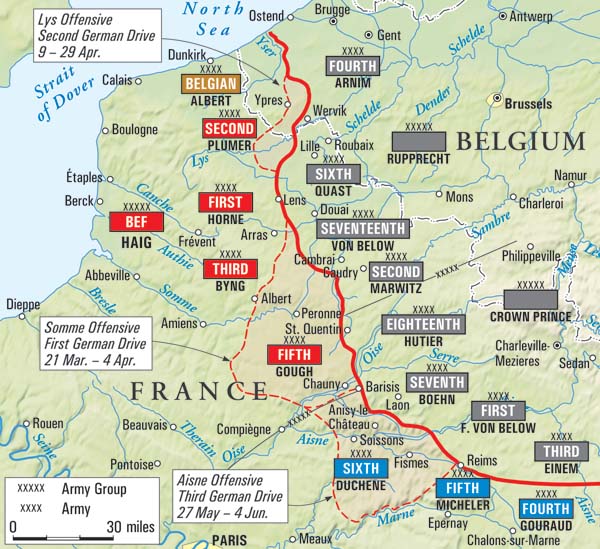
With fewer reinforcements en route from England, Haig was forced to reduce the size of his divisions. He reduced each division from 12 to nine battalions, although the divisions from Canada, Australia, and New Zealand did not make any similar consolidations. While Lloyd George’s steps kept Haig from launching another offensive, they also considerably weakened the strength of the British forces.
In January 1918, the British took responsibility for an additional 25 miles of the French lines on their southern flank near St. Quentin. The British right flank rested on the French village of Barisis, five miles south of the Oise River, stretching British forces to the breaking point. The British were now responsible for defending 126 miles of the 468-mile Western Front.
The 42 miles at the southern end of the British lines was held by General Hubert Gough’s Fifth Army. Its four corps held the right of the British line. Gough’s army had its back to the Somme River and its network of canals. General Julian Byng’s Third Army, to the left of the Fifth Army, held most of the Flesquieres Salient and another 28 miles of the front line north of it. General Henry Horne’s First Army held the ground north of General Byng’s Third Army, while General Henry Rawlinson’s Second Army held the ground north of the British First Army. The Belgian Army anchored the Allied extreme left flank on the coast.
To hold their lines, the British began to construct a three-layered defensive system. The first layer, which was known as the “forward zone,” consisted of machine-gun posts, fortified dugouts, and barbed wire. The British meant this zone to serve only as an outpost line where, in theory, they could bloody the Germans as much as possible before falling back to the second layer. Not entirely grasping the theory of defense in depth, Gough’s Fifth Army had too many troops in its forward zone in some sectors.
The second layer and main defensive line was known as the “battle zone.” It was supposed to be fortified and reinforced with thick strings of barbed wire. The machine-gun positions were to have good fields of fire with artillery in close support. British planners intended troops in this line to hold at all costs, and for this purpose, reserve forces were stationed nearby in order to counterattack and recapture any part of the main line lost to the Germans. The third layer, which was four to eight miles behind the battle zone, was known as the “rear zone.”
It is worth noting that Gough’s battle zone on the eve of the attack was not completed owing to a shortage of laborers. His rear zone, moreover, had not yet been built (only the trenches had been marked out for it).
Though the Germans planned to attack the junction of the French and British lines, they were unaware that Gough’s right flank had been extended south. This meant that Gough’s troops would have to bear the full weight of the German attack intended for the seam between the two armies.
Fortunately for Gough and his troops, the general had received permission from Haig to conduct a fighting withdrawal to the Somme if heavily attacked. Haig also insisted, though, that Gough maintain contact with the British Third Army and hold on until British and French reserves could come to his assistance. Allied commanders had agreed in February that the French would send six divisions to aid Gough if necessary. In return, Haig committed to send help to the French Sixth Army to its right if it should need assistance.
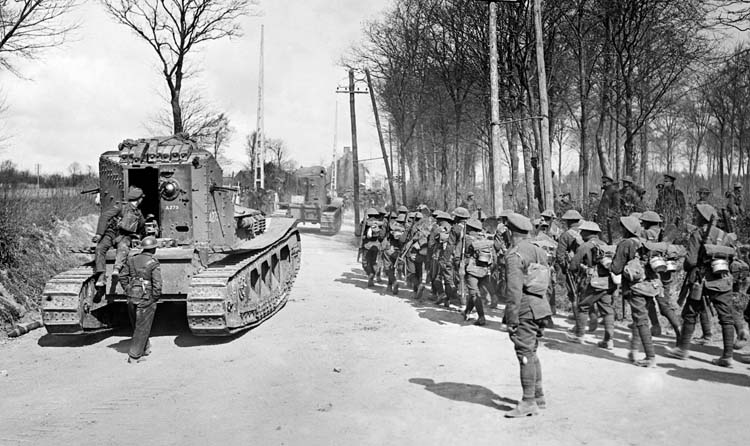
As a result of their aerial reconnaissance and intelligence efforts, the Allies had detected German preparations for the offensive. They were fully aware of enemy troop movements and a buildup of munitions on the German frontline, but there was considerable disagreement as to where the hammer blow would fall. The Germans made small, diversionary attacks against the French line and shelled French troops in the Verdun sector to keep the Allies confused.
Moreover, an observation balloon containing fake plans for an attack against the French was released and allowed to fall to the ground behind French lines. The French wholeheartedly believed that the Germans intended to direct their offensive against them.
Meanwhile, Gough became concerned when he learned that he was facing General von Hutier’s Eighteenth Army. Hutier had a reputation as a determined, resourceful general. Kaiser Wilhelm II had bestowed the Pour le Mérite on von Hutier for capturing Riga in 1917.
German prisoners captured in trench raids, deserters, aerial reports of ammunition dumps, and the presence of large numbers of field guns near the German frontlines all indicated to the British Fifth Army that it was facing a major attack. Gough had every right to be alarmed since his troops were stretched so thin. The stoic soldiers of the British Fifth Army braced themselves for what was likely to be a brutal attack from German armies reinforced from the Eastern Front.
Although they had anticipated a German offensive, the British troops nevertheless were shocked at its initial ferocity. “The barrage fell on us like thunder and lightning, causing the dugout to shiver and quake and stout beams to groan under the shock of direct hits and the waves of blast, which roared down the stairway,” recalled Private Jim Brady of the 3rd Field Ambulance. Wearing gas masks, outnumbered British gunners ignored the shells crashing around them and defiantly returned fire. The creeping barrage that followed the initial bombardment both dazed and shocked British troops in the forward zone of the Third and Fifth Armies. Through the heavy fog, they soon saw well-camouflaged German troops advancing towards them.
“We saw them at about 300 yards,” wrote Private S.S. Taylor of the 1st Wiltshire Regiment. “Their gray uniforms didn’t show up too well against the mist. There were thousands of them, a blanket of men coming straight at us.” Taylor and his comrades resisted as best they could, but German troops were on their flanks and they were quickly overwhelmed. “Bolts out and put your hands up!” shouted Wiltshire’s sergeant to his men to prevent them from being shot down at close range.
Some of the British soldiers on the forward posts put up a strong resistance, managing to keep blazing away on their machine guns well into the second day of the attack. But many posts on this line, isolated by the fog from supporting fire, were quickly overrun by the Germans, who found that the bombardment had smashed British defenses, leaving dishevelled, wounded soldiers and dead bodies scattered about. Some defenders of the first line quickly retreated back to the battle zone, while those captured were sent stumbling like Taylor and his comrades east toward the German lines.
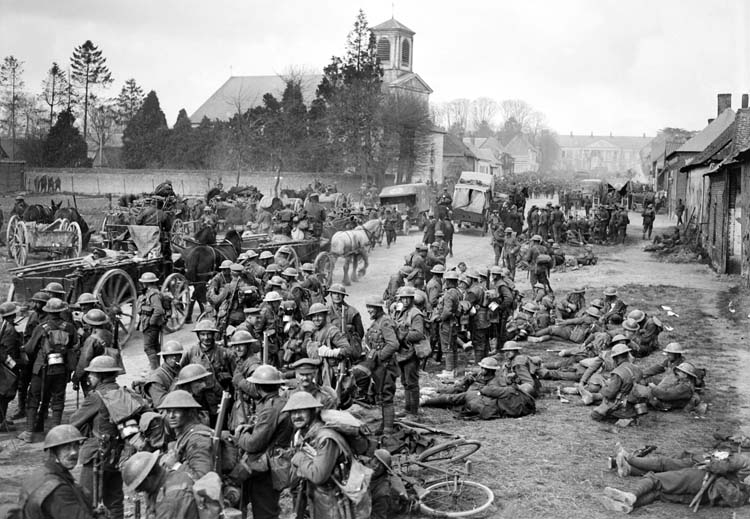
By noon on the first day, the fog had lifted in most places, and the German advance was beginning to slow down, due in part to the churned-up battlefield. German pioneer companies feverishly attempted to fill in shell holes in order to keep the advancing troops moving foward. Horses and gunners were having particular difficulty moving field artillery pieces across the pock-marked terrain. What’s more, British resistance stiffened as the day wore on. “The English second line is being hotly contested, and the enemy artillery is also now intervening more effectively,” wrote Walter Bleam of the 12th Battalion, Grenadier Regiment.
After smashing through the forward zone of the British Third Army, Below’s Seventeenth Army came under heavy fire. The Seventeenth Army had intended to cut the off the northern end of the Flesquieres Salient by pushing toward the village of Ytres. Once it and the Second Army had taken the junction area between the British Third and Fifth Armies, the Seventeenth Army was supposed to swing northwest.
By the end of the first day, though, that objective still remained out of reach. The Seventeenth Army had managed to capture part of the British Third Army’s battle zone, including the village of Demicourt, while repulsing fierce British counterattacks, some of which were supported by tanks. The Germans had advanced nearly three miles in that sector, but their final destination of Ytres still lay more than four miles away.
On the Seventeenth Army’s left flank, the German Second Army attacked the salient from the south, heading for their objective of Equancourt. Although slowed by the fog, the advance troops pushed through the forward zone, leaving behind pockets of resistance. By noon, the Germans had reached the main line held by the Fifth British Army. Fighting raged throughout the rest of the day as Gough’s two northernmost divisions fought desperately to hold the line and Epehy.
“We opened fire,” wrote Lance Cpl. S.T. North of the 7th Leicester Regiment, one of the sector’s British defenders that day. “The Lewis [automatic] guns got busy and the enemy scattered. They had very little cover and no chance of survival.”
The soldiers of Marwitz’s Second Army were unable to cut off the British troops in the salient, but they had taken a good part of the battle zone. They advanced more than two and a half miles but fell more than three and a half miles short of their objective.
Hutier’s Eighteenth Army had the greatest success of the day in its sledgehammer attack on the Second Army’s left flank. It overran the Second Army’s forward zone easily enough, but it stalled against the right flank of the Eighteenth Army in the face of heavy machine-gun fire. On the Eighteenth Army’s left, though, the situation was much worse. It was there that Lt. Gen. Richard Butler’s heavily outnumbered III Corps was unable to stop the Germans at the battle zone.
Greatly concerned over the German troops sweeping against his outspread army, Gough telephoned his corps commanders at 2:00 PM. He ordered them to fight a delaying action until reinforcements arrived, but he warned them not to allow their forces to be destroyed in the battle zone. Gough granted Butler permission to fall back behind the Crozat Canal to his rear.
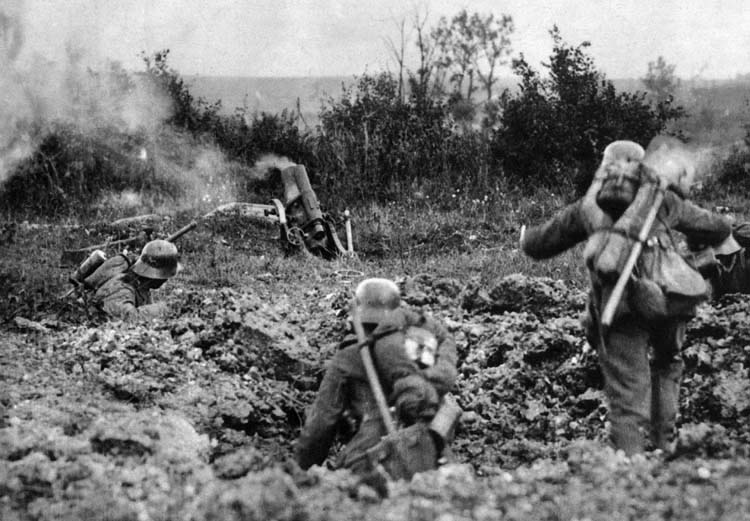
As the fighting died out at nightfall, the British Fifth Army remained in a perilous situation. The German Eighteenth Army stood in a favorable position to continue its advance on the second day. It was here that the Germans had broken through the enemy’s battle zone. In the south, Ludendorff’s attacking forces were to have overrun the Flesquieres Salient on the first day, but they did not achieve their objective.
On most of the battlefront, the Germans had gotten bogged down at the main defensive line of the British defenses. The Germans suffered 40,000 casualties on the first day. As for the British, they lost 38,500 soldiers on the first day, of which 21,000 had been taken prisoner by the advancing Germans.
Ludendorff exhorted Below and Marwitz to complete their occupation of the Flesquieres Salient the following day. Instead of sending their armies reinforcements, though, Ludendorff directed his fresh troops to support Hutier’s army. In so doing, he sought to reinforce the army that had made the most progress on the first day. Just before dawn on March 22, the three German armies renewed their assault in a heavy fog.
The German Seventeenth Army made some gains against the determined defenders of the British Third Army, which was deployed on the north side of the salient. The German Second Army fought its way to Epehy, capturing the village in the early afternoon.
In the late morning of the second day, Gough instructed his corps commanders to conduct a fighting retreat if necessary to the rear zone. Concerned about the III Corps’ withdrawal to the Crozat Canal on his right flank, Lt. Gen. Ivor Maxse ordered his XVIII Corps to fall back nine miles to the Somme, yet Maxse failed to inform the commander of XIX Corps on his left flank of his move. With its right flank unanchored and vulnerable to attack, the XIX Corps had no choice but to retreat as well.
The Germans troops of the Eighteenth Army continued to push Gough’s troops back. “Toward noon, when we neared Jussy, a terrible enemy machine-gun fire met us,” wrote Lieutenant Reinhold Spengler of the 1st Bavarian Regiment. Jussy was situated on the east side of the Crozat Canal near a railway embankment where remnants of a couple of battalions from the Scottish Rifles and the King’s Royal Rifle Corps had entrenched. “Repeated attacks were stopped short of Jussy with heavy losses,” Spengler said.
By nightfall, the situation was now critical for Gough’s army. Though still unbroken, its front line was bending under the strain of German attacks. “I cannot make out why the Fifth Army had gone back so far without making some kind of stand,” said Haig in regard to the crisis that overtook Gough. Haig did his best to stiffen the battered Fifth Army with the resources available to him.
In the early hours of March 23, some units of the German Eighteenth Army advanced to the edge of the Crozat Canal. Captain Eugen von Schobert of the 3rd Bavarian Regiment led his company under the cover of fog to a partially destroyed bridge over the canal. The British had destroyed numerous bridges over the canal, but some could still be crossed. He and his men climbed across the twisted bridge and reached the east side of the canal. Other German units were doing the same.
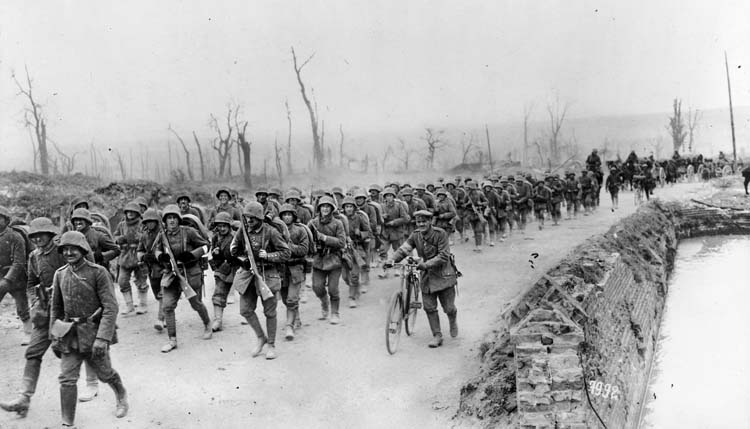
“As soon as we crossed over the canal bridge, the enemy was alerted and opened fire,” wrote Georg Maier of the 1st Bavarian Regiment’s machine-gun company. “Thanks to the fog, he was not able to hit us hard, and our infantry quickly stormed the position where the firing came from, and we followed with our machine guns. The town was soon on fire. It looked grotesque through the dense fog, and we became confused by all the noise of shell fire, rifle and machine-gun fire, and the cries of the wounded.”
Once across the canal at Jussy and elsewhere, the German Eighteenth Army continued their advance westward, rubbing out pockets of resistance and driving back the right wing of the Fifth Army directly in front of them. A dangerous four-mile gap opened up between Gough’s army and the French Sixth Army to their right. Haig had asked the French for help early on March 22 in order to reinforce Gough’s right, and the French had dispatched two infantry divisions, a regiment of field artillery, and three regiments of heavy artillery. They informed the British that they planned to send another four more infantry divisions a short time later. The French reinforcements counterattacked the advancing German Eighteenth Army, but were not strong enough to stop it. When they ran low on ammunition, the French took up defensive positions alongside the British.
The Germans flooded out of Frieres Wood one rank after another in pursuit of the retreating British units. The British responded with heavy fire. “New lines sprang up, and were mown down again until one almost sickened of the slaughter,” wrote Captain R. Chell of the 10th Battalion, Essex Regiment. “[By] nightfall, they were behind us, and only a narrow exit corridor remained. As it was, it was a miracle that any of the battalion got out at all, but we left many, many behind.”
The situation facing the British worsened as they withdrew westward. Attempts to hold the poor defenses of the rear zone about five miles east of the Somme failed to stop the Germans. Bitter fighting raged as elements of the British Fifth Army continued their withdrawal toward the river.
In the late afternoon, Haig issued a sobering order. “Fifth Army must hold the Somme at all costs,” he wrote. “There must be no withdrawal from this line.” He stipulated that his soldiers were to hold the key town of Peronne along the River Somme, where a fortified bridgehead had been established to serve as the link between the Third and Fifth Armies. Unfortunately, Haig’s orders proved impossible to carry out. By the time they were issued, Peronne had been abandoned, and as the battle progressed, the British were unable to stop the Germans at the Somme.
The Kaiser was elated to learn that German forces had fought their way 14 miles into the British lines and captured 40,000 prisoners. “The battle is won,” he crowed prematurely. “The English have been utterly defeated!” In truth, the British were far from defeated, although greatly battered and bloodied.
Allied resistance slowed the advance of both the German Second and Eighteenth Armies. Yet while those forces ran into delays attempting to cross the Somme because the British had blown up most of the bridges over the wide river, the German Seventeenth Army continued to make progress.
The situation north of the Fifth British Army continued to deteriorate as the Flesquieres Salient imploded and the Tommies defending it barely escaped encirclement. The Germans succeeded in forcing the British V and VI Corps of Byng’s Third Army back to the Somme battlefield of 1916, four miles behind Gough’s left flank. Lieutenant General William Congreve’s VII Corps of the Fifth Army made contact with Byng’s troops on March 25.
Greatly disturbed over the quickly deteriorating situation and the possible destruction of the British Fifth Army, Haig asked Marshal Philippe Petain for more reinforcements. Although concerned the Germans might launch an offense in the Champagne region, Petain formed a new army group to take over the battle from the Somme south to the Oise River. Command of this army group was given to General Emile Fayolle. The French general had under his command General Marie Debeney’s First Army and General Georges Humbert’s Third Army.
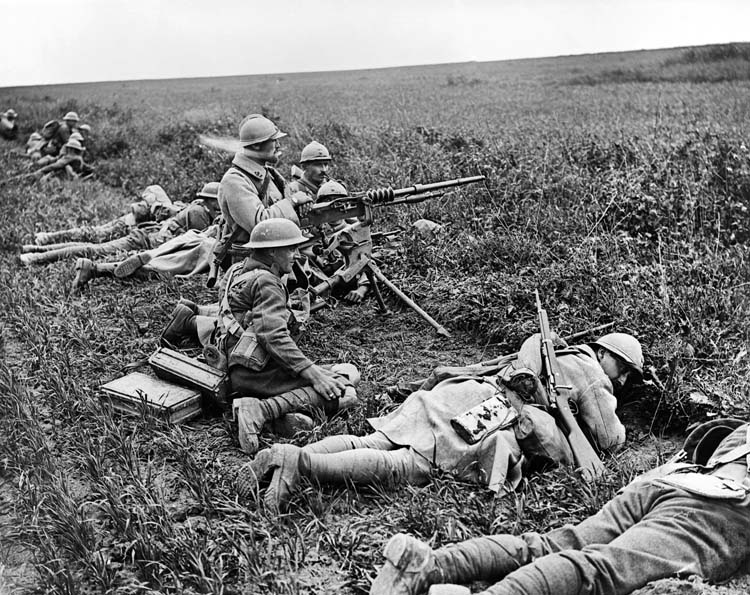
Gough’s army fell under the broad command of Fayolle. It faced a hard task in holding nearly two-thirds of the 36 miles under the French commander’s control. At that point, the Somme became the new dividing line between British and French forces. As for Gough’s troops north of the Somme, they were under Byng’s direction.
Top Allied commanders and politicians met at Doullens on March 26 to deal with the crisis and facilitate better cooperation among Allied commanders. The French representatives at the conference were Pétain, French President Raymond Poincaré, French Premier Georges Clemenceau, and Generals Ferdinand Foch and Maxime Weygand. The British officials in attendance were Secretary of War Alfred Milner, Field Marshal Haig, and Generals Henry Wilson, Herbert Lawrence, and Archibald Montgomery. The conferees signed an agreement designating Foch as the supreme commander of Allied forces on the Western Front. In his new capacity as generalissimo, Foch would be responsible for overseeing and coordinating the actions of all of the Allied armies on the Western Front. The move was done to improve coordination among the Allied armies facing the Germans.
“We must fight in front of Amiens, we must fight where we are now,” said Foch. “As we have not been able to stop the Germans on the Somme, we must not now retire a single inch.” This was easier said than done, though. Ludendorff was now shifting his emphasis to the southwest, where the Second and Eighteenth Armies were doing well. He did this even though it was a deviation from the original objectives of Operation Michael, which called for the main push to be towards the northwest.
Supplying the German Eighteenth and Second Armies as they pushed further away from their railheads was a time-consuming process. Large amounts of materiel had to be transported across abandoned trench lines, through the rubble of villages, and over the pockmarked landscape of the old Somme battlefield. Artillery units that needed to support the infantry attack found it difficult to traverse the battle-scarred terrain. Allied aerial strafing and bombing attacks further hampered this movement of supplies by the few trucks and horses still available. Combined with stiffening Allied resistance, the Germans’ overextended supply and communication lines slowed their advance.
Foch’s first action in his new role was to visit Gough and severely berate him for not being at the front with his troops. He asked the British general to explain the reason he had retreated and had not stood his ground. Before storming off, Foch told Gough that he was not to retreat any further. Despite Foch’s displeasure with Gough’s performance, no reinforcements were offered. By that point, the divisions of the British Fifth Army were down to brigade size, and its brigades were down to battalion size. The Germans had destroyed many British battalions entirely. British battalion commanders issued rifles to rear-echelon personnel, such as clerks, cooks, and engineers, and ordered them to the frontlines. Among the rear-echelon personnel pressed into battle were two companies of American engineers and one company of Canadian engineers.
That same day, Gough’s depleted army continued its fighting withdrawal south of the Somme, aided by heroic rearguard actions. At La Quesnoy, for instance, 100 troops of the 7th Duke of Cornwall’s Light Infantry fought a delaying action that bought the XVIII Corps more than six precious hours, even though its heavy-weapons assets consisted of nothing more than two Lewis guns. Only eleven survivors got away to the British lines.
Fighting continued to rage south of the Somme the next day, March 27. At Rosiéres, the III Corps of the German Eighteenth Army sent wave after wave of field-gray troops against the battered XIX Corps. Machine-gun fire bloodied the German assault troops, as did artillery support. Foch ordered that Rosières be held at all costs, but this was proving difficult, as the British Fifth Army’s left flank along the Somme was open. In mid-afternoon, the Germans pushed south to a point a few miles north of the village of Harbonnières. Their goal was to roll up the British line. To halt the advance of the German 208th Division, British Brig. Gen. E.P. Riddell mounted an artillery horse and led the remnants of his 149th Brigade of the British XIX Corps in a determined counterattack that bought adjacent British units badly needed time to consolidate their positions.
The British XIX Corps’ section of the line held, but the Rosières position had become a salient, and the troops defending the salient were in danger of being cut off by the Germans. Foch gave permission for the XIX Corps to withdraw, which they did, barely escaping. The Fifth Army line was now even closer to Amiens.
The Germans attacked north of the Somme on March 28 between Hendecourt and Lens on a 33-mile front. The goal was to strike northwest toward Arras, finally opening the way to the channel ports. Following a sustained bombardment, 29 German divisions attacked. Byng’s Tommies and Australians greeted the Germans with machine-gun and rifle fire. Suffering heavy casualties and making only slight gains in certain sectors, the attack ground to a halt in the late afternoon. Ludendorff conceded that the attack had failed to achieve its objectives. He subsequently cancelled a follow-up operation known as Valkyrie.
That same day, Gough, who the British government blamed for the Fifth Army’s predicament, was relieved of command, despite Haig’s efforts to save him. General Henry Rawlinson replaced Gough. Taking stock of the situation, Rawlinson warned Foch that Amiens was in danger of falling to the Germans if he did not receive reinforcements within 48 hours.
Ludendorff returned his focus to the area south of the Somme and the capture of Amiens. On March 30, Hutier’s Eighteenth Army struck the French between Noyon and Moreuil on a 25-mile front. The Germans made some noteworthy gains after a hard day of fighting. Meanwhile, the German Second Army attacked the badly battered British Fifth Army east of Amiens. They took Moreuil Wood, located on the southern end of a key ridge where the French and British sectors joined. A fierce charge by the Canadian Cavalry Brigade managed to retake part the woods, but at a heavy cost in troopers and horses. The 3rd Cavalry Brigade soon arrived and managed to clear the woods except for the southern and eastern fringes, which remained in German hands.
In the early hours of March 31, foot soldiers relieved the cavalry in the woods. Throughout the day, the Germans counterattacked, managing by nightfall to hold the woods and the neighboring Rifle Wood. The next day, British and Canadian cavalry attacked again. This time, they went forward dismounted. The woods were taken, and enemy counterattacks were beaten back. The Germans eventually retook the two forests, but enough time had been bought to allow much-needed reinforcements to arrive, including the Australians
There was a lull in the fighting until April 4th, when Ludendorff ordered a limited offensive toward Amiens, about 10 miles behind the British lines. German guns hammered the First French Army for about 75 minutes before attacking at 6:30 AM with 12 divisions. A few French divisions were forced to give way for a couple of miles, but by late afternoon, the French were counterattacking and halting the German Eighteenth Army’s advance.
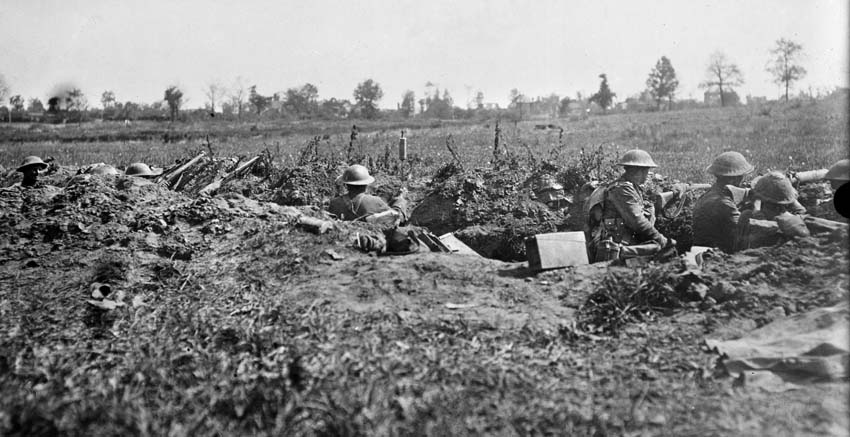
Holding the lines outside of Amiens, the Tommies and Aussies braced themselves for the German Second Army’s onslaught. Fighting raged throughout the day. After two failed assaults, the Germans ultimately captured the village of Dernancourt.
“The first wave of Germans came in massed formation, and they were cut down by machine-gun fire, just like a scythe cuts grass,” recalled Private Stanley Sutcliffe of the 51st Battalion, 4th Australian Division, “but his second wave appeared, so the 2nd Battalion and our 12th Brigade hopped up and met it…The Germans kept being reinforced, with the result that we were pushed back about 1,000 yards.”
Further south, the Germans forced open a gap in the lines between the British and Australians at Villers-Bretonneux. The Bavarian 9th Division came to within 440 yards of the smashed village. This prompted the withdrawal of nearby British batteries. Colonel John Milne, commander of the 36th Australian Battalion, gathered what men he could to prepare a counterattack. “Go ‘til you’re stopped, and hold on at all costs,” Milne told a British company commander; the soldiers rushed forward and drove the enemy back a mile.
Fighting continued the next day, April 5. This time, it was the French counterattacking Hutier’s exhausted Eighteenth Army that made little gain. Meanwhile, the German Second Army attempted to outflank Villers-Bretonneux, but it was halted by machine-gun fire and artillery support. Attacks against Byng’s troops further north fared little better. “The enemy’s resistance was beyond our powers,” said Ludendorff that evening. He ordered his generals to stop their attacks.
Operation Michael was over. By that point, upwards of 100,000 reinforcements had arrived from England to bolster the British armies. The worn-out, demoralized Germans had suffered 239,000 casualties in two weeks of horrific fighting. Although the Germans put a 40-mile dent in the Allied lines, they failed to separate the French and British lines. Indeed, they compelled the Allied High Command to improve its operations through the appointment of Foch as its generalissimo. The Allies had dashed the German High Command’s hope of driving the British forces to the English Channel.
The British had suffered 178,000 casualties, 72,000 of them captured in combat. For their part, the French suffered 77,000 killed, wounded, and captured. With the Americans coming, the Allies could replace their loses, while the Germans could not.
The German spring offensive was far from over. They launched operations in Flanders as well against the French at Chemin des Dames in a drive toward Paris, but once again, these offensives failed to achieve a breakthrough, and attacks continued against the French into July. After having suffered staggeringly heavy casualties, the Germans had little hope of victory. Their attacks ceased in midsummer. Despite the best efforts of Ludendorff and his soldiers, the Allies had stopped one of the most potentially devastating German offensives of the war.
On August 8, the Allies launched their Hundred Days Offensive. It began with the British victory at Amiens, which Ludendorff described as “the black day of the German Army.” The French pushed forward in the center, while the Americans fought their way forward on the Allied right. German defenses crumbled under the pressure of relentless attacks. The Germans signed the armistice on November 11. Peace returned, but it was not a lasting one.
